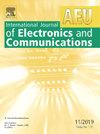具有任意数量的实频率传输零对的最优切比雪夫低通滤波器
IF 3
3区 计算机科学
Q2 ENGINEERING, ELECTRICAL & ELECTRONIC
Aeu-International Journal of Electronics and Communications
Pub Date : 2025-04-29
DOI:10.1016/j.aeue.2025.155813
引用次数: 0
摘要
研究了在最优切比雪夫全极滤波器的特征函数中引入不同的有限透射零对的效果。为了保证等纹阻带,采用牛顿-拉夫逊方法确定传输零点位置。提出了一种将特征函数的超越形式转化为有理多项式形式的新方法。值得注意的是,推导过程很简单,不需要递归或优化。这些滤波器在通带中保持相同的幅度响应,同时与等纹全极滤波器相比,具有增强的阻带性能。为了说明该方法的有效性,本文给出了具有一个、两个或三个不同的简单传输零的七度最优切比雪夫低通滤波器的近似过程,实现了50db的最小阻带衰减。对比分析表明,所提滤波器的性能有所提高。本文章由计算机程序翻译,如有差异,请以英文原文为准。
Optimum Chebyshev low-pass filter with an arbitrary number of real-frequency transmission zero pairs
The paper examines the effect of introducing distinct pairs of finite transmission zeros into the characteristic function of an optimum Chebyshev all-pole filter. To ensure the equiripple stopband, the transmission zero locations are determined using the Newton–Raphson method. A novel approach is proposed to transform the characteristic function from its transcendental into a rational polynomial form. Notably, the derivation process is straightforward, eliminating the need for recursion or optimization. These filters preserve the same magnitude response in the passband, while achieving enhanced stopband performance compared to their equiripple all-pole counterparts. To illustrate the effectiveness of this method, an approximation procedure is presented for a 7th-degree optimum Chebyshev low-pass filter with one, two, or three distinct simple transmission zeros, achieving a minimum stopband attenuation of 50 dB. A comparative analysis demonstrates the enhanced performance of the proposed filters.
求助全文
通过发布文献求助,成功后即可免费获取论文全文。
去求助
来源期刊
CiteScore
6.90
自引率
18.80%
发文量
292
审稿时长
4.9 months
期刊介绍:
AEÜ is an international scientific journal which publishes both original works and invited tutorials. The journal''s scope covers all aspects of theory and design of circuits, systems and devices for electronics, signal processing, and communication, including:
signal and system theory, digital signal processing
network theory and circuit design
information theory, communication theory and techniques, modulation, source and channel coding
switching theory and techniques, communication protocols
optical communications
microwave theory and techniques, radar, sonar
antennas, wave propagation
AEÜ publishes full papers and letters with very short turn around time but a high standard review process. Review cycles are typically finished within twelve weeks by application of modern electronic communication facilities.

 求助内容:
求助内容: 应助结果提醒方式:
应助结果提醒方式:


